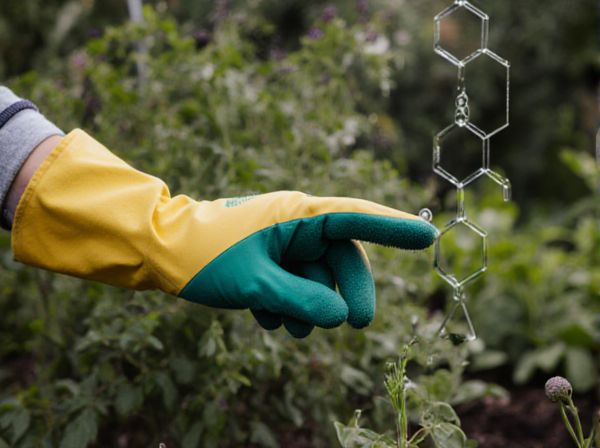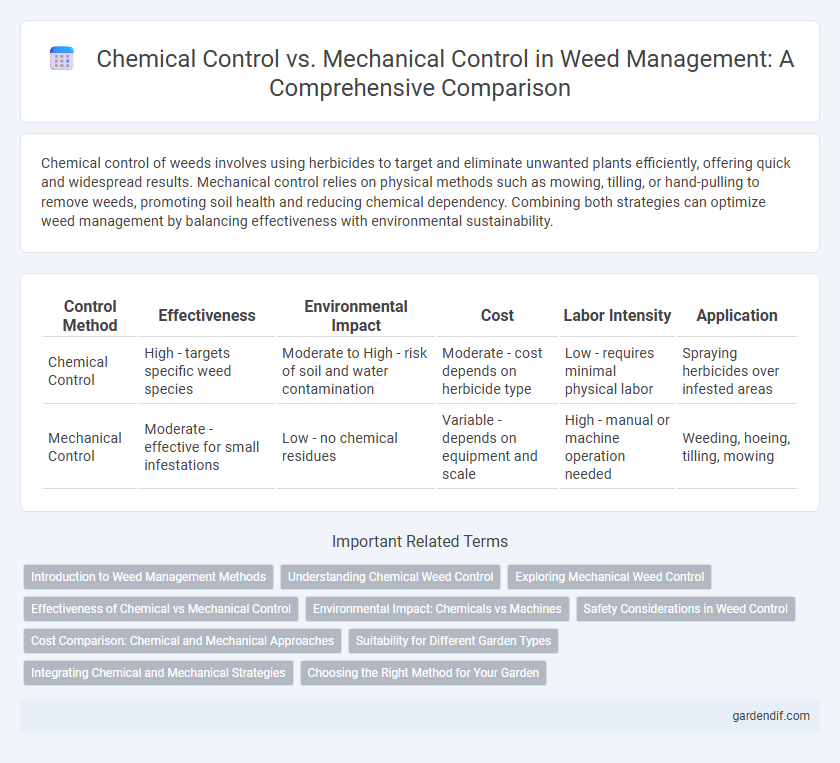
Chemical control vs Mechanical control Illustration
Chemical control of weeds involves using herbicides to target and eliminate unwanted plants efficiently, offering quick and widespread results. Mechanical control relies on physical methods such as mowing, tilling, or hand-pulling to remove weeds, promoting soil health and reducing chemical dependency. Combining both strategies can optimize weed management by balancing effectiveness with environmental sustainability.
Table of Comparison
| Control Method | Effectiveness | Environmental Impact | Cost | Labor Intensity | Application |
|---|---|---|---|---|---|
| Chemical Control | High - targets specific weed species | Moderate to High - risk of soil and water contamination | Moderate - cost depends on herbicide type | Low - requires minimal physical labor | Spraying herbicides over infested areas |
| Mechanical Control | Moderate - effective for small infestations | Low - no chemical residues | Variable - depends on equipment and scale | High - manual or machine operation needed | Weeding, hoeing, tilling, mowing |
Introduction to Weed Management Methods
Chemical control utilizes herbicides to target specific weed species, offering rapid and effective suppression with precision application. Mechanical control involves physical methods such as tilling, mowing, or hand-pulling to remove weeds and disrupt their growth cycles, often enhancing soil health and reducing dependence on chemicals. Integrating chemical and mechanical control techniques forms a comprehensive weed management strategy that maximizes efficacy and sustainability.
Understanding Chemical Weed Control
Chemical weed control involves the use of herbicides that target specific weed species, enabling efficient management of large infestations. Understanding the mode of action, application timing, and environmental impact of herbicides is crucial to maximize efficacy and minimize resistance development. Proper chemical control complements integrated weed management by reducing the seed bank and improving crop yield stability.
Exploring Mechanical Weed Control
Mechanical weed control offers an environmentally friendly alternative to chemical herbicides by physically removing or disrupting weed growth through methods such as tilling, mowing, and mulching. This approach minimizes soil chemical residues, reduces the risk of herbicide resistance in weed populations, and promotes soil health by maintaining microbial activity and organic matter. Employing mechanical techniques supports sustainable agriculture practices while effectively managing weed infestations in diverse cropping systems.
Effectiveness of Chemical vs Mechanical Control
Chemical control of weeds offers rapid and targeted suppression through herbicides, proving highly effective against widespread or deep-rooted infestations. Mechanical control, including methods like tillage and hand weeding, is labor-intensive but beneficial for preventing herbicide resistance and preserving soil health. Combining both approaches can enhance overall weed management efficacy by leveraging the speed of chemical methods and the sustainability of mechanical techniques.
Environmental Impact: Chemicals vs Machines
Chemical control of weeds often involves herbicides that can contaminate soil and water, harming non-target plant and animal species while potentially leading to resistant weed populations. Mechanical control employs physical methods like tilling or mowing, which minimize chemical pollution but may cause soil erosion and disrupt beneficial organisms. Balancing environmental impact requires evaluating trade-offs between chemical residues and mechanical soil disturbance to optimize sustainable weed management strategies.
Safety Considerations in Weed Control
Chemical control in weed management requires careful handling of herbicides to prevent toxicity risks, environmental contamination, and harm to non-target organisms, emphasizing the use of protective gear and adherence to application guidelines. Mechanical control, including methods like tilling and mowing, offers a safer alternative by minimizing chemical exposure but demands attention to operator safety and equipment maintenance to avoid physical injuries. Integrating both approaches with safety protocols optimizes weed control effectiveness while protecting human health and the environment.
Cost Comparison: Chemical and Mechanical Approaches
Chemical weed control typically involves lower initial labor costs but higher expenses for herbicides and potential environmental compliance. Mechanical control demands significant labor investment and equipment costs yet avoids chemical purchases and reduces long-term environmental impact expenses. Evaluating overall cost-effectiveness depends on weed species, infestation scale, and sustainability goals, with integrated approaches often balancing economic and ecological factors.
Suitability for Different Garden Types
Chemical control offers effective weed management in large-scale gardens and commercial landscapes where uniform application is feasible and quick results are essential. Mechanical control suits smaller, organic, or environmentally sensitive gardens by physically removing weeds without introducing harmful chemicals, preserving soil health and beneficial organisms. Hybrid approaches combining selective herbicides with manual weeding optimize weed control tailored to diverse garden sizes and ecological priorities.
Integrating Chemical and Mechanical Strategies
Integrating chemical and mechanical control strategies enhances weed management by combining the precision of herbicides with the physical removal benefits of mechanical methods. Utilizing targeted herbicide applications reduces weed populations, while mechanical practices such as tillage and mowing disrupt weed growth cycles and soil seed banks. This integrated approach minimizes herbicide resistance, improves long-term control efficacy, and supports sustainable agricultural practices.
Choosing the Right Method for Your Garden
Selecting the appropriate weed control method depends on the specific garden needs and plant types present. Chemical control offers rapid and effective weed eradication, particularly for large infestations, but requires careful application to avoid harming desirable plants and the environment. Mechanical control, including hand weeding and hoeing, provides a safer, eco-friendly alternative that promotes soil health and is ideal for small to medium-sized gardens with diverse plantings.
Chemical control vs Mechanical control Infographic

 gardendif.com
gardendif.com